Titanium Dioxide, but Not Zinc Oxide, Nanoparticles Cause Severe Transcriptomic Alterations in T98G Human Glioblastoma Cells
Abstract
1. Introduction
2. Results
2.1. Physicochemical Properties of Nanoparticles
Stability of NPs in Water and Cell Culture Medium
2.2. Uptake of NPs in T98G Glioblastoma Cells
2.2.1. Microscopy
2.2.2. Flow Cytometry
2.3. Effects of NPs on T98G Cell Viability
2.4. Massive Parallel Sequencing of RNA of the Cells Exposed to NPs
2.4.1. Differentially Expressed Genes
2.4.2. Annotation of the Differentially Expressed Genes
2.4.3. Altered Molecular Pathways
2.5. Proteomic Alterations in the T98G Cells Exposed to TiO2-NPs
2.6. Validation of Massive Parallel Sequencing by PCR
2.6.1. Selecting Housekeeping Genes
2.6.2. Expressions of the Selected Genes
2.6.3. Effect of the Concentration of TiO2-NPs on Gene Expressions
2.7. Autophagy Induced by TiO2-NPs
2.8. Effect of NPs on the Secretion of IL6 and IL8
3. Discussion
3.1. Physical Properties of NPs
3.2. Uptake of NPs
3.3. Cytotoxicity
3.4. Transcriptomic Alterations Induced by NPs
3.4.1. Immunological Alterations
3.4.2. Maintaining the BBB
3.5. Autophagy
3.6. Potential Anticancerigen Role of TiO2-NPs
4. Materials and Methods
4.1. Nanoparticles
4.2. Physicochemical Characterisation of Nanoparticles
4.2.1. Particle Size in Water by Dynamic Light Scattering
4.2.2. Z-Potential in Water
4.2.3. Transmission Electron Microscopy
4.2.4. Stability of NPs in the Cell Culture Medium
4.3. Cellular Cultures
4.4. Cellular Exposure to Nanoparticles
4.5. Cellular Viability Tests
4.6. Flow Cytometry
4.7. Electron Microscopy
4.8. RNA Isolation
4.9. Massive Parallel RNA Sequencing
4.10. Bioinformatic Analysis
4.11. Validation of Massive Parallel RNA Sequencing by Real-Time PCR
4.12. Proteomic Determinations
4.12.1. Trypsin Digestion
4.12.2. HPLC-MS/MS Analysis
4.13. Interleukin Determinations
5. Conclusions
Supplementary Materials
Author Contributions
Funding
Institutional Review Board Statement
Informed Consent Statement
Data Availability Statement
Acknowledgments
Conflicts of Interest
References
- Hoyt, B.W.; Mason, E. Nanotechnology Emerging health issues. J. Chem. Health Saf. 2008, 15, 10–15. [Google Scholar] [CrossRef]
- EUON (European Union Observatory for Nanomaterials). Available online: https://euon.echa.europa.eu/ (accessed on 29 December 2020).
- Vance, M.E.; Kuiken, T.; Vejerano, E.P.; McGinnis, S.P.; Hochella, M.F., Jr.; Rejeski, D.; Hull, M.S. Nanotechnology in the real world: Redeveloping the nanomaterial consumer products inventory. Beilstein J. Nanotechnol. 2015, 6, 1769–1780. [Google Scholar] [CrossRef] [PubMed]
- European Chemical Agency (ECHA). Available online: https://www.echa.europa.eu/ (accessed on 29 December 2020).
- European Commission (EC). Catalogue of Nanomaterials Used in Cosmetic Products Placed on the Market. 2016. Available online: https://ec.europa.eu/docsroom/documents/35411 (accessed on 29 December 2020).
- Wei, L.; Feng, X.; Chen, A.; Zhang, Y.; Wang, J.; Shao, L. Application of dental nanomaterials: Potential toxicity to the central nervous system. Int. J. Nanomed. 2015, 10, 3547–3565. [Google Scholar] [CrossRef] [PubMed]
- Mishra, P.K.; Mishra, H.; Ekielski, A.; Talegaonkar, S.; Vaidya, B. Zinc oxide nanoparticles: A promising nanomaterial for biomedical applications. Drug Discov. Today 2017, 22, 1825–1834. [Google Scholar] [CrossRef]
- Organization for Economic Cooperation and Development (OECD). Series on the Safety of Manufactured Nanomaterials No. 27: List of Manufactured Nanomaterials and List of Endpoints for Phase One of the Sponsorship Programme for the Testing of Manufactured Nanomaterials: Revision. 2010. Available online: http://www.oecd.org/officialdocuments/publicdisplaydocumentpdf/?cote=env/jm/mono(2010)46&doclanguage=en (accessed on 29 December 2020).
- Boyes, W.K.; van Thriel, C. Neurotoxicology of Nanomaterials. Chem. Res. Toxicol. 2020, 33, 1121–1144. [Google Scholar] [CrossRef]
- Jia, J.; Wang, Z.; Yue, T.; Su, G.; Teng, C.; Yan, B. Crossing Biological Barriers by Engineered Nanoparticles. Chem. Res. Toxicol. 2020, 33, 1055–1060. [Google Scholar] [CrossRef]
- Lee, J.; Jeong, J.-S.; Kim, S.Y.; Park, M.-K.; Choi, S.-D.; Kim, U.-J.; Park, K.; Jeong, E.J.; Nam, S.-Y.; Yu, W.-J. Titanium dioxide nanoparticles oral exposure to pregnant rats and its distribution. Part. Fibre Toxicol. 2019, 16, 1–12. [Google Scholar] [CrossRef]
- Kao, Y.-Y.; Cheng, T.-J.; Yang, D.-M.; Wang, C.-T.; Chiung, Y.-M.; Liu, P.-S. Demonstration of an Olfactory Bulb–Brain Translocation Pathway for ZnO Nanoparticles in Rodent Cells In Vitro and In Vivo. J. Mol. Neurosci. 2012, 48, 464–471. [Google Scholar] [CrossRef]
- Migliore, L.; Uboldi, C.; Di Bucchianico, S.; Coppedè, F. Nanomaterials and neurodegeneration. Environ. Mol. Mutagen. 2015, 56, 149–170. [Google Scholar] [CrossRef]
- Barres, B.A.; Freeman, M.R.; Stevens, B. Glia; Cold Spring Harbor: New York, NY, USA, 2015; ISBN 978-1-62182-027-7. [Google Scholar]
- Fuster, E.; Candela, H.; Estévez, J.; Arias, A.J.; Vilanova, E.; Sogorb, M.A. Effects of silver nanoparticles on T98G human glioblastoma cells. Toxicol. Appl. Pharmacol. 2020, 404, 115178. [Google Scholar] [CrossRef]
- Uniprot Data Base Accession Number Q86VV4: Ran-Binding Protein 3-Like (RANBP3L). Available online: https://www.uniprot.org/uniprot/Q86VV4 (accessed on 29 December 2020).
- Ensembl Database Accession Number AC087741.2. Available online: http://www.ensembl.org/Homo_sapiens/Gene/Summary?g=ENSG00000275479;r=17:80149627-80149798;t=ENST00000619415 (accessed on 29 December 2020).
- Uniprot Database Accession Number Q6ZWJ8: Kielin/Chordin-Like Protein (KCP). Available online: https://www.uniprot.org/uniprot/Q6ZWJ8 (accessed on 29 December 2020).
- Uniprot Database Accession Number P01100: Proto-Oncogene c-Fos (FOS). Available online: https://www.uniprot.org/uniprot/P01100 (accessed on 29 December 2020).
- Uniprot Database Accession Number Q14934: Nuclear Factor of Activated T-Cells, Cytoplasmic 4 (NFATC4). Available online: https://www.uniprot.org/uniprot/Q14934 (accessed on 29 December 2020).
- National Academy of Sciences. Committee on Toxicity Testing and Assessment of Environmental Agents, National Research Council. Toxicity Testing in the 21st Century: A Vision and a Strategy. 2007. Available online: http://nap.edu/11970 (accessed on 29 December 2020).
- Schulze, C.; Kroll, A.; Lehr, C.-M.; Schäfer, U.F.; Becker, K.; Schnekenburger, J.; Isfort, C.S.; Landsiedel, R.; Wohlleben, W. Not ready to use—Overcoming pitfalls when dispersing nanoparticles in physiological media. Nanotoxicology 2008, 2, 51–61. [Google Scholar] [CrossRef]
- Powers, K.W.; Palazuelos, M.; Moudgil, B.M.; Roberts, S.M. Characterization of the size, shape, and state of dispersion of nanoparticles for toxicological studies. Nanotoxicology 2007, 1, 42–51. [Google Scholar] [CrossRef]
- Zhang, Y.; Chen, Y.; Westerhoff, P.; Hristovski, K.; Crittenden, J.C. Stability of commercial metal oxide nanoparticles in water. Water Res. 2008, 42, 2204–2212. [Google Scholar] [CrossRef] [PubMed]
- Zucker, R.M.; Massaro, E.J.; Sanders, K.M.; Degn, L.L.; Boyes, W.K. Detection of TiO2 nanoparticles in cells by flow cytometry. Cytom. Part A 2010, 77, 677–685. [Google Scholar] [CrossRef] [PubMed]
- Lai, J.C.; Lai, M.B.; Jandhyam, S.; Dukhande, V.V.; Bhushan, A.; Daniels, C.K.; Leung, S.W. Exposure to titanium dioxide and other metallic oxide nanoparticles induces cytotoxicity on human neural cells and fibroblasts. Int. J. Nanomed. 2008, 3, 533–545. [Google Scholar]
- Wang, J.; Deng, X.; Zhang, F.; Chen, D.; Ding, W. ZnO nanoparticle-induced oxidative stress triggers apoptosis by activating JNK signaling pathway in cultured primary astrocytes. Nanoscale Res. Lett. 2014, 9, 117. [Google Scholar] [CrossRef]
- Altunbek, M.; Keleştemur, S.; Baran, G.; Çulha, M. Role of modification route for zinc oxide nanoparticles on protein structure and their effects on glioblastoma cells. Int. J. Biol. Macromol. 2018, 118, 271–278. [Google Scholar] [CrossRef]
- Uniprot Database Accession Number P14174: Macrophage Migration Inhibitory Factor (MIF). Available online: https://www.uniprot.org/uniprot/P14174 (accessed on 29 December 2020).
- Villeneuve, D.L.; Landesmann, B.; Allavena, P.; Ashley, N.; Bal-Price, A.; Corsini, E.; Halappanavar, S.; Hussell, T.; Laskin, D.; Lawrence, T.; et al. Representing the Process of Inflammation as Key Events in Adverse Outcome Pathways. Toxicol. Sci. 2018, 163, 346–352. [Google Scholar] [CrossRef]
- Amiri, S.; Yousefi-Ahmadipour, A.; Hosseini, M.-J.; Haj-Mirzaian, A.; Momeny, M.; Hosseini-Chegeni, H.; Mokhtari, T.; Kharrazi, S.; Hassanzadeh, G.; Amini, S.M.; et al. Maternal exposure to silver nanoparticles are associated with behavioral abnormalities in adulthood: Role of mitochondria and innate immunity in developmental toxicity. NeuroToxicology 2018, 66, 66–77. [Google Scholar] [CrossRef]
- Zijno, A.; Cavallo, D.; Di Felice, G.; Ponti, J.; Barletta, B.; Butteroni, C.; Corinti, S.; De Berardis, B.; Palamides, J.; Ursini, C.L.; et al. Use of a common European approach for nanomaterials’ testing to support regulation: A case study on titanium and silicon dioxide representative nanomaterials. J. Appl. Toxicol. 2020, 40, 1511–1525. [Google Scholar] [CrossRef]
- Abbott, N.J.; Patabendige, A.A.K.; Dolman, D.E.M.; Yusof, S.R.; Begley, D.J. Structure and function of the blood–brain barrier. Neurobiol. Dis. 2010, 37, 13–25. [Google Scholar] [CrossRef]
- Liu, S.; Calderwood, D.A.; Ginsberg, M.H. Integrin cytoplasmic domain-binding proteins. J. Cell Sci. 2000, 113, 3563–3571. [Google Scholar]
- Klezovitch, O.; Vasioukhin, V. Cadherin signaling: Keeping cells in touch. F1000Research 2015, 4, 550. [Google Scholar] [CrossRef] [PubMed]
- Suzuki, H.; Tabata, K.; Morita, E.; Kawasaki, M.; Kato, R.; Dobson, R.C.; Yoshimori, T.; Wakatsuki, S. Structural basis of the autophagy-related LC3/Atg13 LIR complex: Recognition and interaction mechanism. Structure 2014, 22, 47–58. [Google Scholar] [CrossRef] [PubMed]
- Saha, S.; Panigrahi, D.P.; Patil, S.; Bhutia, S.K. Autophagy in health and disease: A comprehensive review. Biomed. Pharmacother. 2018, 104, 485–495. [Google Scholar] [CrossRef]
- Uniprot Database Accession Number Q13501: Sequestosome-1 (SQSTM1). Available online: https://www.uniprot.org/uniprot/Q13501 (accessed on 29 December 2020).
- Wang, B.; Zhang, J.; Chen, C.; Xu, G.; Qin, X.; Hong, Y.; Bose, D.D.; Qiu, F.; Zou, Z. The size of zinc oxide nanoparticles controls its toxicity through impairing autophagic flux in A549 lung epithelial cells. Toxicol. Lett. 2018, 285, 51–59. [Google Scholar] [CrossRef]
- Thorn, C.F.; Oshiro, C.; Marsh, S.; Hernandez-Boussard, T.; McLeod, H.; Klein, T.E.; Altman, R.B. Doxorubicin pathways: Pharmacodynamics and adverse effects. Pharmacogenet. Genomics 2011, 21, 440–446. [Google Scholar] [CrossRef]
- Edwardson, D.W.; Narendrula, R.; Chewchuk, S.; Mispel-Beyer, K.; Mapletoft, J.P.; Parissenti, A.M. Role of Drug Metabolism in the Cytotoxicity and Clinical Efficacy of Anthracyclines. Curr. Drug Metab. 2015, 16, 412–426. [Google Scholar] [CrossRef]
- Portela, M.; Venkataramani, V.; Fahey-Lozano, N.; Seco, E.; Losada-Perez, M.; Winkler, F.; Casas-Tintó, S. Glioblastoma cells vampirize WNT from neurons and trigger a JNK/MMP signaling loop that enhances glioblastoma progression and neuro-degeneration. PLoS Biol. 2019, 17, e3000545. [Google Scholar] [CrossRef] [PubMed]
- Uniprot Database Accession Number P98172: Ephrin-B1 (EFNB1). Available online: https://www.uniprot.org/uniprot/P98172 (accessed on 29 December 2020).
- Hamik, A.; Wang, B.; Jain, M.K. Transcriptional Regulators of Angiogenesis. Arter. Thromb. Vasc. Biol. 2006, 26, 1936–1947. [Google Scholar] [CrossRef] [PubMed]
- Li, Y.-J.; Lei, Y.-H.; Yao, N.; Wang, C.-R.; Hu, N.; Ye, W.-C.; Zhang, D.-M.; Chen, Z.-S. Autophagy and multidrug resistance in cancer. Chin. J. Cancer 2017, 36, 1–10. [Google Scholar] [CrossRef] [PubMed]
- Mi, H.; Muruganujan, A.; Casagrande, J.T.; Thomas, P.D. Large-scale gene function analysis with the PANTHER classification system. Nat. Protoc. 2013, 8, 1551–1566. [Google Scholar] [CrossRef] [PubMed]
- Terron, A.; Bal-Price, A.; Paini, A.; Monnet-Tschudi, F.; Bennekou, S.H.; Leist, M.; Schildknecht, S. An adverse outcome pathway for parkinsonian motor deficits associated with mitochondrial complex I inhibition. Arch. Toxicol. 2018, 92, 41–82. [Google Scholar] [CrossRef] [PubMed]
- Heringa, M.B.; Peters, R.J.B.; Bleys, R.L.A.W.; Van Der Lee, M.K.; Tromp, P.C.; Van Kesteren, P.C.E.; Van Eijkeren, J.C.H.; Undas, A.K.; Oomen, A.G.; Bouwmeester, H. Detection of titanium particles in human liver and spleen and possible health implications. Part. Fibre Toxicol. 2018, 15, 1–9. [Google Scholar] [CrossRef] [PubMed]
- Heringa, M.B.; Geraets, L.; Van Eijkeren, J.C.H.; Vandebriel, R.J.; De Jong, W.H.; Oomen, A.G. Risk assessment of titanium dioxide nanoparticles via oral exposure, including toxicokinetic considerations. Nanotoxicology 2016, 10, 1515–1525. [Google Scholar] [CrossRef] [PubMed]
- Rompelberg, C.; Heringa, M.B.; Van Donkersgoed, G.; Drijvers, J.; Roos, A.; Westenbrink, S.; Peters, R.; Van Bemmel, G.; Brand, W.; Oomen, A.G. Oral intake of added titanium dioxide and its nanofraction from food products, food supplements and toothpaste by the Dutch population. Nanotoxicology 2016, 10, 1404–1414. [Google Scholar] [CrossRef]
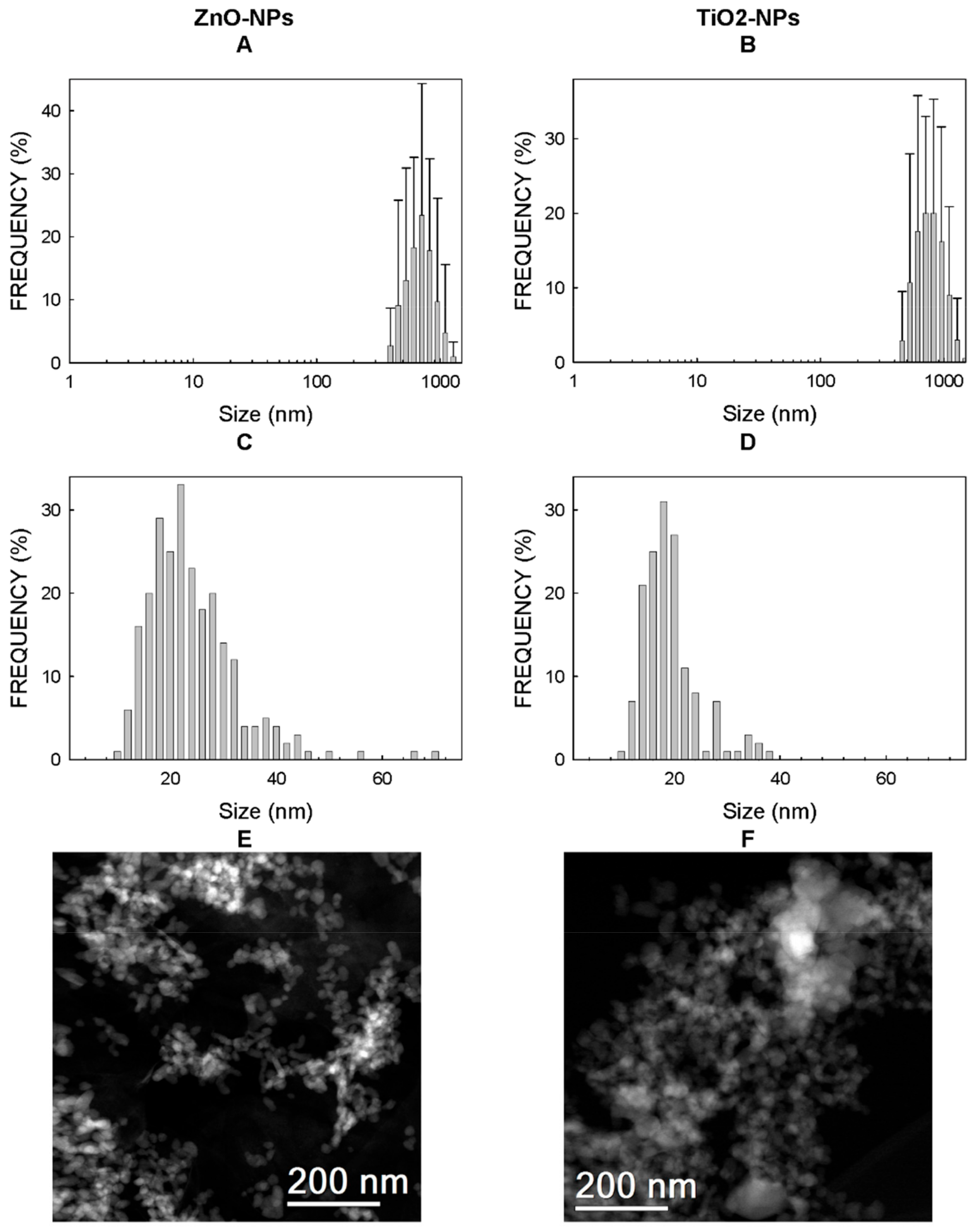
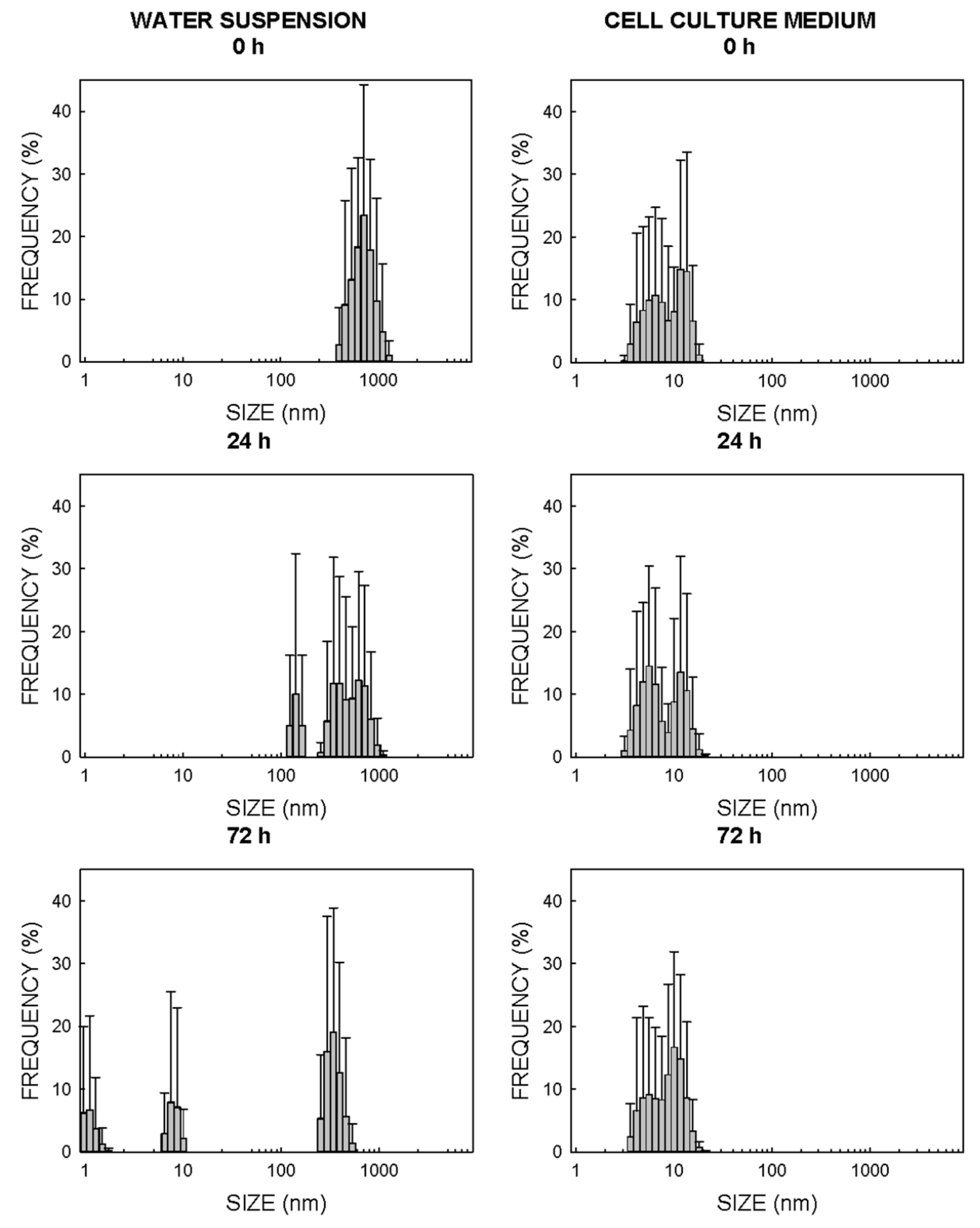
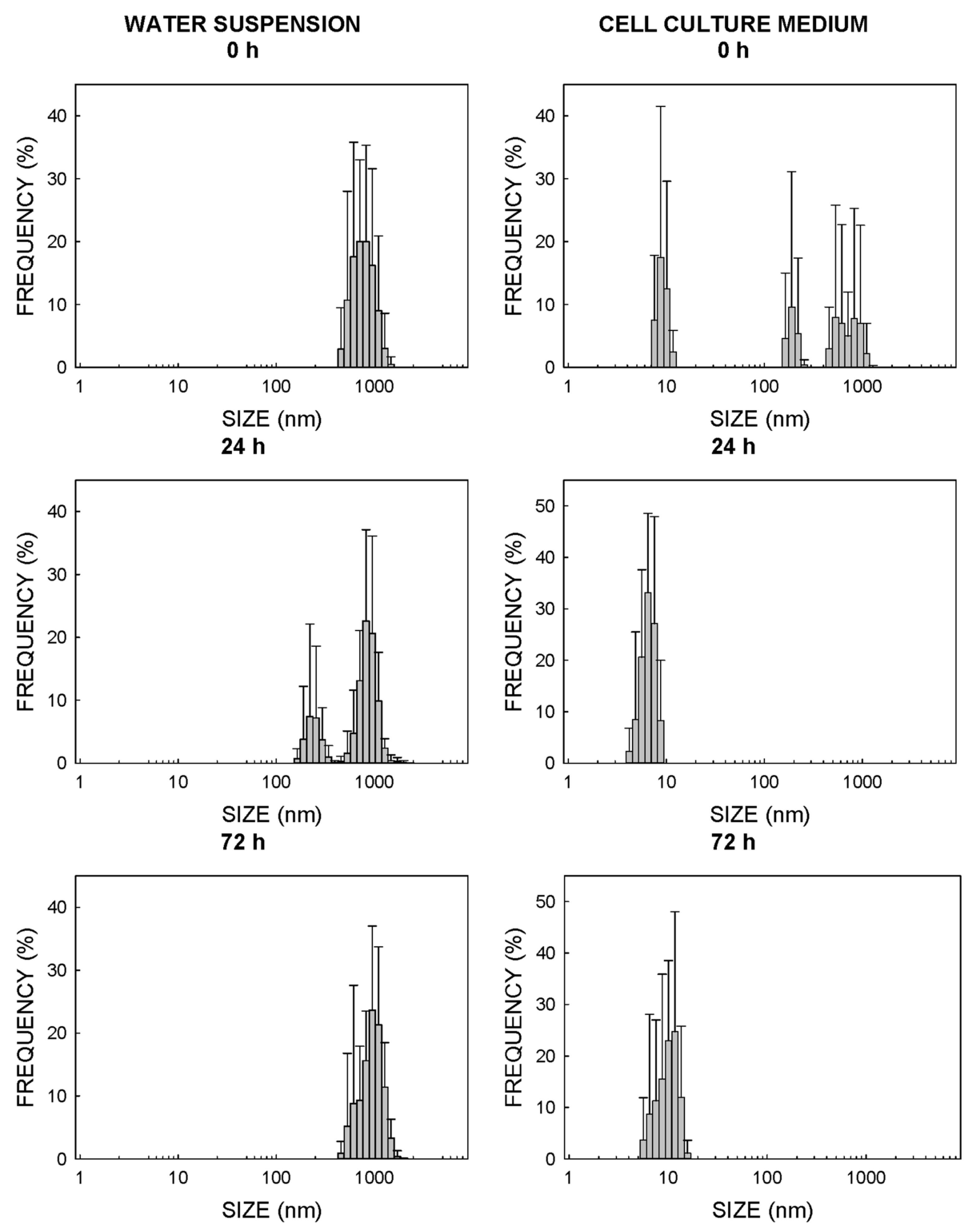
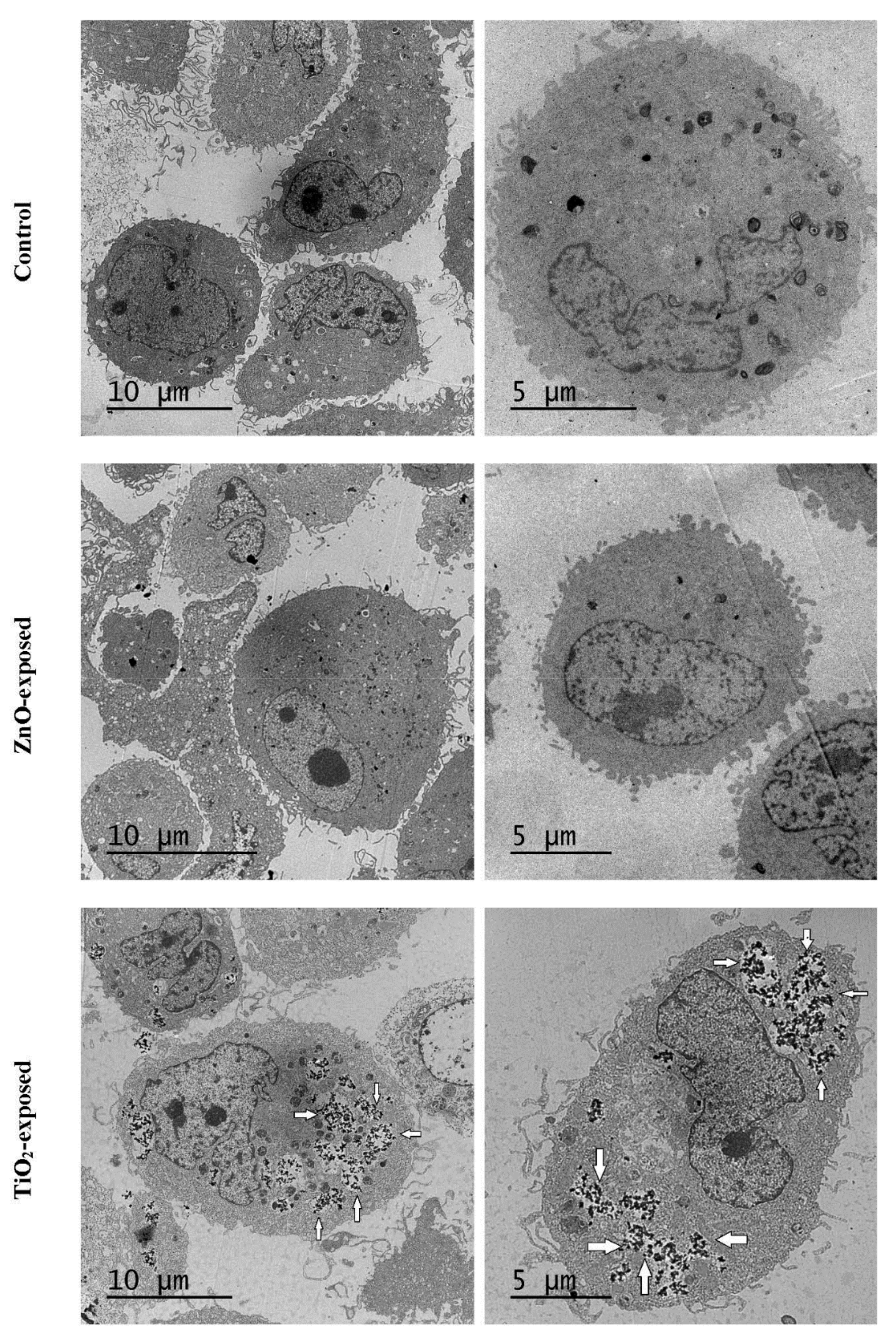
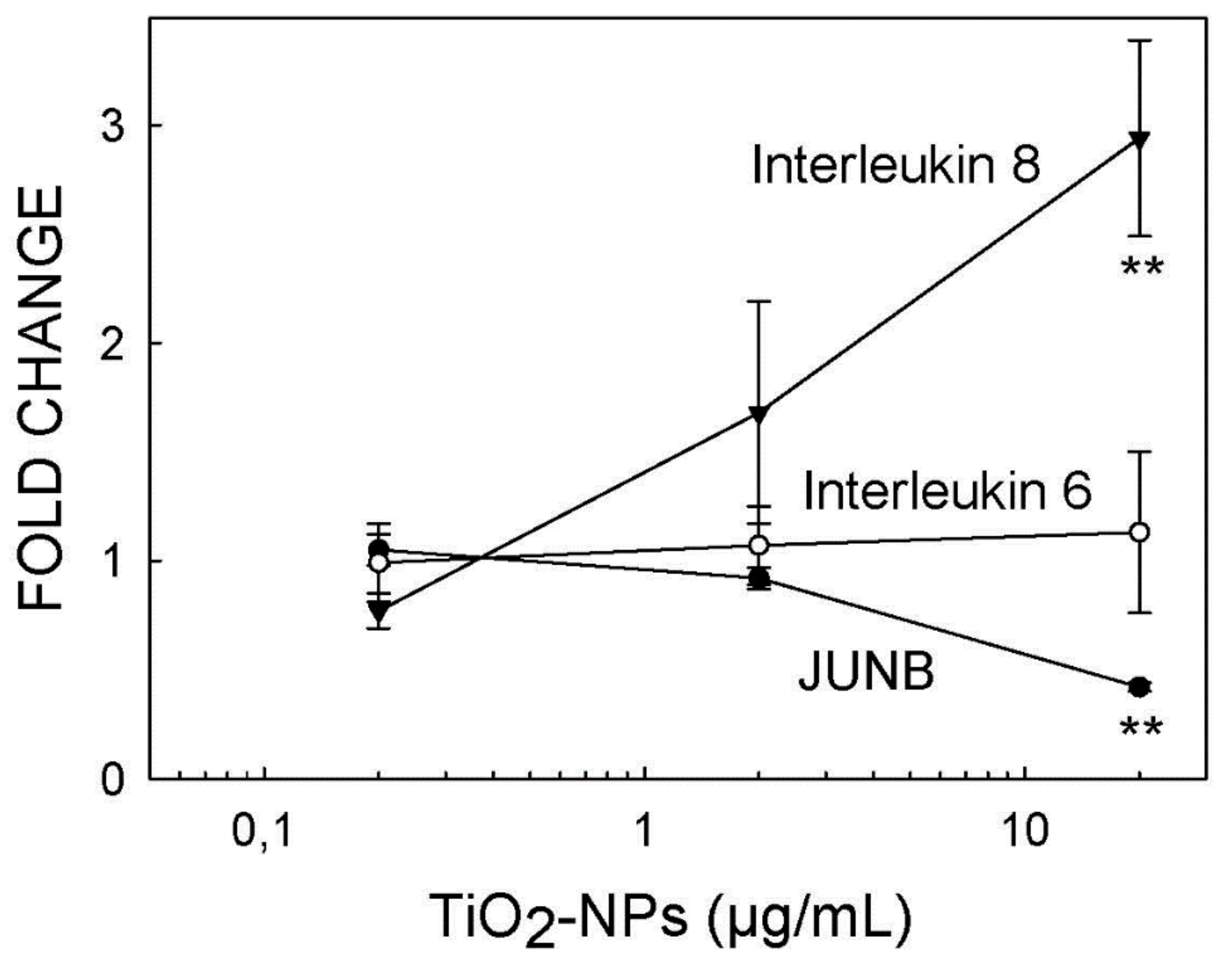
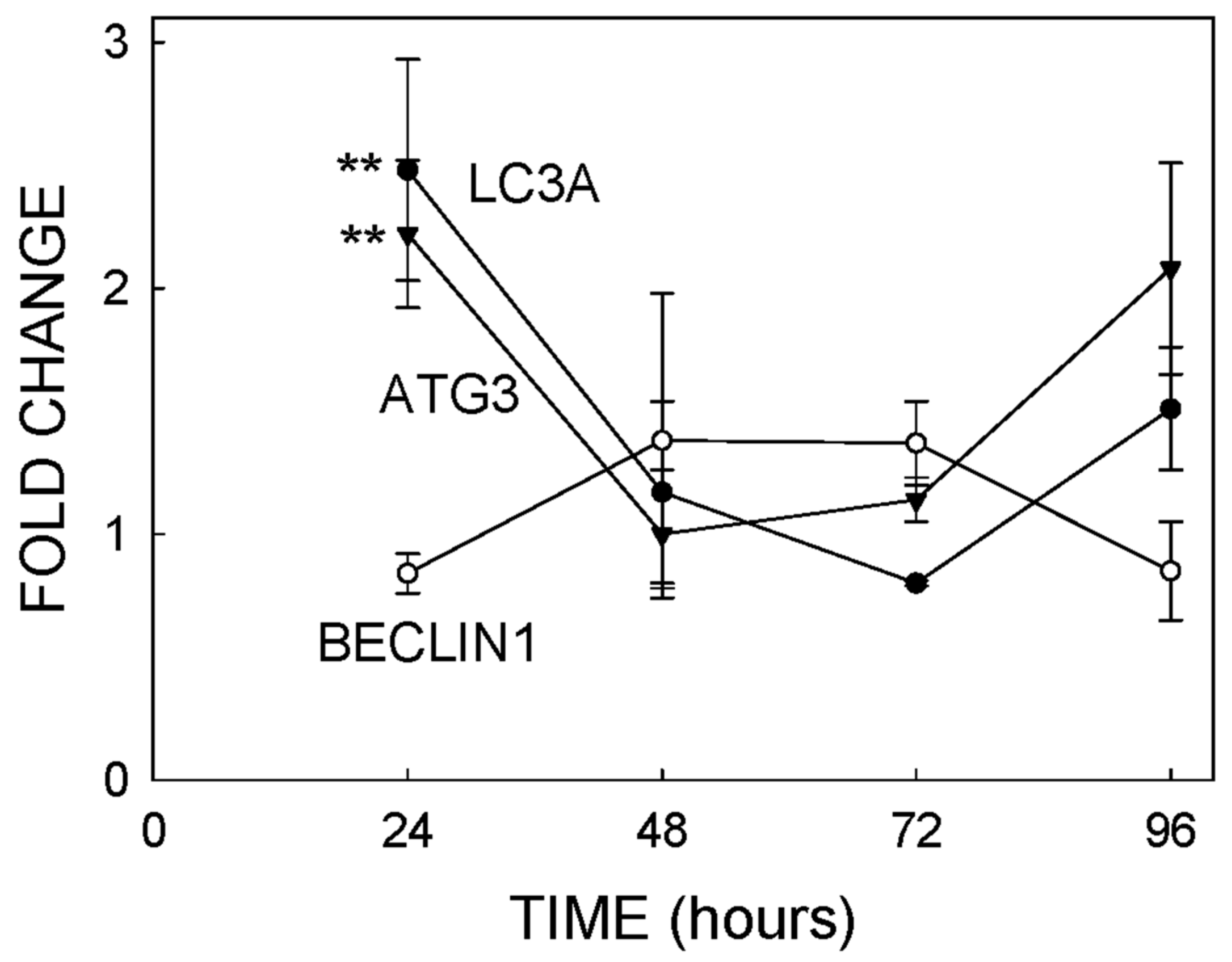
| Physical Parameter | ZnO-NPs | TiO2-NP |
|---|---|---|
| Mean size by DLS (nm) | 707.9 ± 173.3 | 786.9 ± 176.7 |
| Mean size by TEM (nm) | 23.15 ± 8.65 | 18.18 ± 5.25 |
| Z-potential (mV) | +17.0 ± 0.6 | +22.8 ± 0.8 |
| Nanoparticle | Experiment 1 (72 h) | Experiment 2 (24 h) | Experiment 3 (72 h) | |||||
|---|---|---|---|---|---|---|---|---|
| SSC | Ratio | SSC | Ratio | Viability (%) | SSC | Ratio | Viability (%) | |
| Control | 1168 | 1038 | 98 | 816 | 98 | |||
| 1186 | 979 | 98 | 680 | 96 | ||||
| (1177) | 1 | (1009) | 1 | (98) | (748) | 1.00 | (97) | |
| ZnO-NPs | 1192 | 1133 | 97 | 1003 | 92 | |||
| 1281 | 1122 | 98 | 1031 | 96 | ||||
| 1237 | 1.05 | (1128) | 1.12 | (98) | (1017) | 1.36 | (94) | |
| TiO2-NP | 2000 | 3904 | 90 | 5327 | 92 | |||
| 2244 | 4059 | 92 | 4786 | 91 | ||||
| (2122) | 1.8 | (3982) | (3.95) | (91) | (5057) | 6.76 | (92) | |
| Nanoparticle | Concentration (µg/mL) | % of Viability (n) |
|---|---|---|
| ZnO-NPs | 10 | 87 ± 1 (n = 5) |
| 5 | 92 ± 1 (n = 4) | |
| TiO2-NPs | 30 | 87 ± 5 (n = 4) |
| 20 | 90 ± 3 (n = 6) | |
| 15 | 92 ± 2 (n = 6) | |
| 10 | 93 ± 1 (n = 6) |
| Biological Process Sub-Ontology (GO Term) | Genes in Reference List | Genes among DEG | Expected among DEG | EF | p-Value | FDR |
|---|---|---|---|---|---|---|
| Granulocyte chemotaxis (GO:0071621) | 8 | 3 | 0.14 | 22 | 7.26 × 10−4 | 4.98 × 10−2 |
| Response to lipopolysaccharide (GO:0032496) | 13 | 4 | 0.23 | 18 | 1.63 × 10−4 | 1.87 × 10−2 |
| Positive regulation of multicellular organismal process (GO:0051240) | 18 | 4 | 0.31 | 13 | 4.69 × 10−4 | 3.66 × 10−2 |
| Response to cytokine (GO:0034097) | 39 | 6 | 0.68 | 9 | 1.06 × 10−4 | 1.51 × 10−2 |
| Regulation of cell differentiation (GO:0045595) | 50 | 7 | 0.87 | 8 | 4.80 × 10−5 | 8.23 × 10−3 |
| Transmembrane receptor protein tyrosine kinase signaling pathway (GO:0007169) | 89 | 8 | 1.54 | 5 | 2.43 × 10−4 | 2.31 × 10−2 |
| Cell adhesion (GO:0007155) | 146 | 12 | 2.53 | 5 | 1.59 × 10−5 | 1.37 × 10−2 |
| Generation of neurons (GO:0048699) | 122 | 9 | 2.11 | 4 | 3.96 × 10−4 | 3.24 × 10−2 |
| Molecular Function Sub-Ontology (GO Term) | Genes in Reference List | Genes among DEG | Expected among DEG | EF | p-Value | FDR |
|---|---|---|---|---|---|---|
| Integrin binding (GO:0005178) | 14 | 4 | 0.24 | 16 | 2.07 × 10−4 | 3.42 × 10−2 |
| Cytokine activity (GO:0005125) | 32 | 5 | 0.55 | 9 | 3.81 × 10−4 | 2.70 × 10−2 |
| RNA polymerase II proximal promoter sequence-specific DNA binding (GO:0000978) | 71 | 7 | 1.23 | 6 | 3.55 × 10−4 | 2.93 × 10−2 |
| Signaling receptor activity (GO:0038023) | 231 | 13 | 4.00 | 3 | 2.75 × 10−4 | 3.42 × 10−2 |
| Pathway | Genes Involved | Log2 Fold Change |
|---|---|---|
| Angiogenesis | Ephrin-B1 | −1.08 |
| Proto-oncogene c-Fos | −1.68 | |
| TGF-beta signaling pathway | Transcription factor JUN-B | −1.26 |
| Inhibin beta A chain | 1.14 | |
| Heterotrimeric G-protein signaling pathway and Gi alpha and Gs alpha mediated pathway | Regulator of G-protein signaling | −1.36 |
| Alpha-1D adrenergic receptor | −1.38 | |
| Adenosine receptor A1 | −1.71 | |
| Blood coagulation | Tissue-type plasminogen activator | 1.17 |
| Integrin beta 3 | 1.59 | |
| p53 pathway | Thrombospondin-1 | −1.02 |
| Ribonucleoside-diphosphate reductase subunit M2 | −1.13 | |
| Cadherin signaling pathway | Protein Wnt-6 | −1.14 |
| Protocadherin-18 | −1.43 | |
| Cadherin-11 | −1.13 | |
| Interleukin signaling pathway | Interleukin 8 | 1.51 |
| Proto-oncogene c-Fos | −1.68 | |
| Integrin signaling pathway | Integrin beta 8 | −1.32 |
| Integrin alpha X | 1.06 | |
| Rho-related GTP-binding protein RhoE | 1.03 | |
| Laminin subunit alpha-4 | −1.14 | |
| Integrin beta 3 | 1.59 | |
| CCKR signaling map | Early growth response protein 1 | −2.48 |
| Transcription factor 4 | −1.20 | |
| Regulator of G−protein signaling 2 | −1.36 | |
| Interleukin-8 | 1.51 | |
| Proto-oncogene c−Fos | −1.68 | |
| Inflammation mediated by chemokine and cytokine signaling pathway | 1-phosphatidylinositol 4,5-bisphosphate phosphodiesterase delta-4 | −1.18 |
| Nuclear factor of activated T-cells, cytoplasmic 4 | −1.07 | |
| C3a anaphylatoxin chemotactic receptor | 1.33 | |
| Interleukin 8 | 1.51 | |
| Transcription factor JUN-B | −1.26 | |
| C-C motif chemokine 2 | −1.72 | |
| EGF receptor signaling pathway | Pro-neuregulin-1, membrane-bound isoform | 1.25 |
| Protein sprouty homolog 4 | −1.54 | |
| Heterotrimeric G-protein signaling pathway-Gq alpha and Go alpha-mediated pathway | Regulator of G-protein signaling 2 | −1.36 |
| Adenosine receptor A1 | −1.71 | |
| Parkinson’s disease | Heat shock 70-kDa protein 1A | 1.33 |
| Heat shock 70-kDa protein 1B | 1.29 | |
| Synphilin-1 | 2.07 | |
| B-cell activation | Nuclear factor of activated T-cells, cytoplasmic 4 | −1.07 |
| B-cell receptor CD22 | 1.84 | |
| Proto-oncogene c-Fos | −1.68 | |
| Gonadotropin releasing hormone receptor pathway | Nuclear factor of activated T-cells, cytoplasmic 4 | −1.07 |
| Early growth response protein 1 | −2.48 | |
| Heat shock 70-kDa protein 1A | 1.33 | |
| Transcription factor JUN-B | −1.26 | |
| Heat shock 70-kDa protein 1B | 1.29 | |
| Muellerian-inhibiting factor | −1.01 | |
| Inhibin beta A chain 08476 | 1.14 | |
| Proto-oncogene c-Fos | −1.68 | |
| Cyclic AMP-dependent transcription factor ATF-3 | 1.11 | |
| Apoptosis signaling pathway | Heat shock-70 kDa protein 1A | 1.33 |
| Heat shock-70 kDa protein 1B | 1.29 | |
| Proto-oncogene c-Fos | −1.68 | |
| Cyclic AMP-dependent transcription factor ATF-3 | 1.11 | |
| Wnt signaling pathway | Nuclear factor of activated T-cells, cytoplasmic 4 | −1.07 |
| Protein Wnt-6 | −1.14 | |
| Protocadherin-18 | −1.43 | |
| Cadherin-11 | −1.13 | |
| T cell activation | HLA class II histocompatibility antigen gamma chain | −1.43 |
| Nuclear factor of activated T-cells, cytoplasmic 4 | −1.07 | |
| Proto-oncogene c-Fos | −1.68 |
| Biological Process Sub-Ontology (GO Term) | Proteins in Reference List | Proteins among DEP | Expected among DEP | EF | p-Value | FDR |
|---|---|---|---|---|---|---|
| Doxorubicin metabolic process (GO:0044598) | 9 | 2 | 0.01 | >100 | 1.94 × 10−5 | 2.57 × 10−25 |
| Daunorubicin metabolic process (GO:0044597) | 9 | 2 | 0.01 | >100 | 1.94 × 10−5 | 2.37 × 10−2 |
| Interleukin 12-mediated signaling pathway (GO:0035722) | 46 | 3 | 0.03 | >100 | 3.35 × 10−9 | 1.78 × 10−2 |
| Cell-cell recognition (GO:0009988) | 69 | 3 | 0.04 | 70.2 | 1.08 × 10−5 | 1.90 × 10−2 |
| Protein folding (GO:0006457) | 220 | 4 | 0.14 | 29 | 8.34 × 10−6 | 1.66 × 10−2 |
| Symbiotic process (GO:0044403) | 783 | 5 | 0.48 | 10 | 7.34 × 10−5 | 4.49 × 10−2 |
| Organic substance catabolic process (GO:1901575) | 1771 | 7 | 1.10 | 6.4 | 3.34 × 10−5 | 2.65 × 10−2 |
| Regulation of biological quality (GO:0065008) | 4073 | 11 | 2.52 | 4.4 | 7.82 × 10−7 | 6.21 × 10−3 |
| Transport (GO:0006810) | 4550 | 10 | 2.82 | 3.5 | 3.42 × 10−5 | 2.59 × 10−2 |
| Relative Expression PCR Experiment 1 | Relative Expression PCR Experiment 2 | ||||
|---|---|---|---|---|---|
| Gene | RNAseq | GAPDH | PGK1 | GAPDH | PGK1 |
| IL6 | - | 0.96 ± 0.07 | 0.88 ± 0.21 | 0.90 ± 0.15 | 0.84 ± 0.17 |
| IL8 | 2.85 | 2.84 ± 0.04 *** | 2.59 ± 0.25 ** | 2.86 ± 0.40 ** | 2.68 ± 0.59 ** |
| JUN B | 0.42 | 0.15 ± 0.11 ** | 0.14 ± 0.18 ** | 0.21 ± 0.02 ** | 0.19 ± 0.05 * |
| Sample | IL8 (%) in Experiment 1/2/3 | |
|---|---|---|
| 72-h exposure | ||
| TiO2-NPs | 128 **/133 **/143 *** | |
| ZnO-NPs | 95/103/113 * | |
| Positive control | 217 ***/223 ***/230 *** | |
| 24-h exposure | ||
| TiO2-NPs | 146 */135 ** | |
| ZnO-NPs | 87 */101 | |
| Positive control | 315 ***/228 | |
Publisher’s Note: MDPI stays neutral with regard to jurisdictional claims in published maps and institutional affiliations. |
© 2021 by the authors. Licensee MDPI, Basel, Switzerland. This article is an open access article distributed under the terms and conditions of the Creative Commons Attribution (CC BY) license (http://creativecommons.org/licenses/by/4.0/).
Share and Cite
Fuster, E.; Candela, H.; Estévez, J.; Vilanova, E.; Sogorb, M.A. Titanium Dioxide, but Not Zinc Oxide, Nanoparticles Cause Severe Transcriptomic Alterations in T98G Human Glioblastoma Cells. Int. J. Mol. Sci. 2021, 22, 2084. https://doi.org/10.3390/ijms22042084
Fuster E, Candela H, Estévez J, Vilanova E, Sogorb MA. Titanium Dioxide, but Not Zinc Oxide, Nanoparticles Cause Severe Transcriptomic Alterations in T98G Human Glioblastoma Cells. International Journal of Molecular Sciences. 2021; 22(4):2084. https://doi.org/10.3390/ijms22042084
Chicago/Turabian StyleFuster, Encarnación, Héctor Candela, Jorge Estévez, Eugenio Vilanova, and Miguel A. Sogorb. 2021. "Titanium Dioxide, but Not Zinc Oxide, Nanoparticles Cause Severe Transcriptomic Alterations in T98G Human Glioblastoma Cells" International Journal of Molecular Sciences 22, no. 4: 2084. https://doi.org/10.3390/ijms22042084
APA StyleFuster, E., Candela, H., Estévez, J., Vilanova, E., & Sogorb, M. A. (2021). Titanium Dioxide, but Not Zinc Oxide, Nanoparticles Cause Severe Transcriptomic Alterations in T98G Human Glioblastoma Cells. International Journal of Molecular Sciences, 22(4), 2084. https://doi.org/10.3390/ijms22042084







